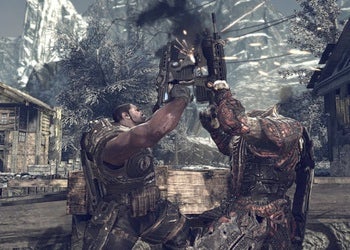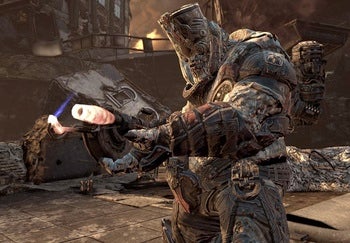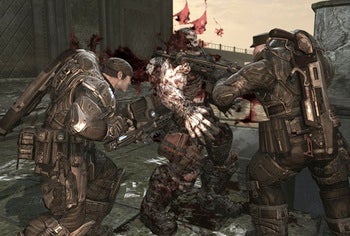
While most of us probably think of fables as charming if occasionally eerie bedtime morality tales packing cliched life lessons like rubber bullets, the term is also occasionally used in a more disparaging sense to connote something false, or put a bit more generously, something that's not exactly true. "What is history," asked Napoleon, "but a fable agreed upon?" What is reality, to extend the metaphor, but group subscriber fiction? What is a video game about a yokel who eventually pulls himself up by several dozen designer-dyed pairs of bootstraps to save the world, but an echo of an atavistic power fantasy?
Don't worry. You're not expected to answer much less ask those sorts of questions as you're traipsing about Fable II's glamorous bosky timberlands and gassy bogs bedding lovers, raising kids, chasing dogs, and dispatching trolls with roots sprouting from their heads like dreadlocks. It's never on the lips of the tatty-trousered or fancy-bonneted citizens that frequent Albion's muddy lanes and cobblestone boulevards, sighing and dreaming out loud and occasionally pausing to hail or curse your titled good name ("Lionheart"? "Dog Lover"?). There's never a wrestling match with a fanged grad school quandary or a gauntlet of snarling obversions, syllogisms, and transpositions. You're not here to solve for X or to prove that pink elephants don't exist, or that polka-dotted ones do.
And yet there is a deep and abiding philosophical principle coiled through Fable II's uncanny physiology like an invisible spine. It's a bit easier to spot when you compare Peter Molyneux's gradual evolution from a sort of mad genius converting gorgeous Rube Goldberg contraptions into half-playable games asking "What do you think of playing this?" to his work on Fable II, clear evidence of a mature designer who's finally figured out how to extricate pathos from all that whiz-bang and make his lovely Rube Goldberg widgets service the nervous system of a more fundamental and transformative question: "How do you feel when playing this?"
Easily asked, perilously answered, and yet Molyneux's Fable II antes up, supposing what might happen when not just one but a startling array of play styles are accommodated, where the classic notion of "winning" is turned on its head, and where "failure" is just another chance to offer more entertainment.
And that would be Fable II's most intrepid gamble: It's essentially impossible to lose. I don't mean impossible in terms of "quit, load save game, repeat with clean slate." You'll incidentally have to turn off your Xbox if you want to restart the game from a save state, but by the time you realize this, it's already irrelevant. The whole idea that you're a walking bag of numbers on the verge of scooping up some more numbers on the road to "success by mathematical aggregate" is more or less out the window, replaced by a system that's built instead to sense when you're bumping up against a personal vertical and either help you tilt that angle down a bit, or convince you to give something else a go instead. Not completing a task doesn't equal not completing a task, it just means trying something else for a bit, sort of like pinballing between casino games. And that's another way of thinking about Fable II: an elaborate game of chance, one in which you're constantly hedging this activity against that one for fame or fortune.
Even when you die -- the archetypal "fail state" in any game -- you actually don't. Instead, you shudder to the ground and reality buckles for a few tense seconds, then you rise to your feet and wade right back into the fray. No fuss, no muss. No reloads from save points or long treks back from distant penalty points. Just a little face and body scarring and the potential loss of experience orbs dropped by slain creatures (you have to vacuum these up or you'll forfeit them). It's part of a design philosophy that says "I've been you, I know what you hate about these games, and I hate the schoolboy design stuff as much as you do."
Schoolboy indeed. Sure, you're still shackled to a certain elemental formula here, still observing the rudimentary "zero-to-hero" monomyth whose central tenet commands Thou Shalt Start Out Wimpy on the battle-snarled road to celebrity fame, rocklike pectorals, and a brimming logbook's worth of statistical trophies tallying everything from how many times you've paid for sex to the number of people you've sacrificed at the local cult temple.
And yet you're not really following anything, because regardless of the brief-sounding 12 or so hour Aristotelian narrative that slices through Fable II's shifting geology like a granite arrow, following that arrow never feels inexorable -- a "wander off the beaten path" trick other games have certainly attempted. But where those others compose broadly on a canvas thin as the rubber skin of a balloon, Fable II knits limited geographical regions together using a network of casual mini-games that beckon like an epic interregional midway you can cruise at your leisure. We're talking romance, sex (with condoms or without), marriage, child-rearing, family upkeep, bounty hunting, cult worshipping, thieving, buying and selling real estate, merchandizing, woodcutting, blacksmithing, bartending, modeling, chicken-kicking, rabbit-shooting, treasure-hunting, and some 14 distinctive types of criminal activity, from drunk and disorderly conduct to violating parole.
Now imagine those activities feeding into each other, a matrix of ricocheting, optional to-dos that shape and describe the sum total of your life-as-entertainment in this game. Don't think side quests, think "dozens and dozens of main quests" that don't branch so much as crisscross -- nothing ever feels subsidiary to an overarching imperative, though the drama of the main story is always there, cleverly woven into the fabric of each locale and eerily resonant in dialogue that feels emergent even though you know it's not.
Save for the indelible electric blue scars that accrue on your face and body from battle (in triplicate if you fight and flounder frequently) nothing in Fable II is immutable. Drive the locals mad by sleeping premaritally with everyone in sight and it's the work of a few minutes tenderizing with gifts and wielding desirable expressions like dancing and belching or flexing and farting to make them fall in love with your silly self all over again. Consequences still matter, but think long term, because their impact isn't always immediately apparent. The sell point here is that if you work hard enough, you can push the world or be pulled by it, no unstoppable narrative forces, no immovable design objects.
Part of that work involves combat, of course, which follows a masterfully executed third principle: acclimation. You'd expect a traditionalist to balk at the notion of one-button combat (one for melee, one for ranged, and one for magic) and yet the game keeps you so busy juggling so many different tasks that by the time you're thinking "Where's my block-dodge-flank buttons?" you're unlocking the first of several one-button variations. One isn't just the loneliest number, it's also the most deceptive. Think how many rhythms a drummer can coax out of a single drumhead, and you've got the basic sense of how Fable II's one-button combat evolves using time and rhythm the way other games use finger-gnarling button combos.
Add the variable timed interplay between melee, ranged, and magical abilities, namely how long it takes to execute each, the tactically unique and mostly challenging ways in which each of your opponent's behaves, and the fact that scooping up experience orbs left by slain creatures makes you vulnerable, and you have a battle system that's almost miraculously nuanced and instantly accessible to a five-year-old.
I'd be remiss not to mention how gorgeous Fable II looks and sounds, from the moment the game opens with crackling rubbish bins flanked by gleaming snow and calliopes dolorously huffing and grinding beside polychromatic wagons, on through the dazzling stand-still-to-watch sunrises and sunsets. It's in the subtle things, too, like the way your heightened awareness of the world during revelatory moments invokes a deadening of hues, or the way others react dramatically to events and affect your experience empathically. It's startling how much more effective something as simple as a companion heaving his guts out at a horrifying situation can be than simply smearing the screen with gore. And it's one thing to see a dilapidated bridge in a game, but entirely another when someone else is articulating somewhat timorously that it looks rickety. Occasionally the maxim "show don't tell" calls for reversal, something Fable II's design team understands intuitively.
I've made it to this point and only mentioned the dog once. That's intentional. It's because I'm with Molyneux when he says: "The dog...it's just a dog." He's underplaying his hand, of course, since he knows anything more would lead to hype and disappointment. Make what you will of the dog's companionship. I think he's a terrific way to add a nonverbal companion as well as a dramatic linchpin for...well, you'll have to see for yourself. In the end, he's mostly there to pull you off the game's auto-mapping "bread crumb trail" that ably points the way to whatever you've targeted. For me, he was actually therapeutic, a friendly corrective for my somewhat neurotic tendency to scour every square inch of the map before moving on. With the dog, for the first time ever, I completely relaxed. If he barked, I listened, and that was enough.
Does it matter that the pause-menu inventory screens feel sluggish and can't be bothered to sort items alpha-numerically? (I'm looking at you, Lucien's diary notes.) That each area map crams its lengthy indexes of shops and special locations into just one or two scrollable lines? That the general world map never displays where you are in relation to anything? Nothing's perfect, but it's somewhat baffling that the tactical AI does such an able job challenging you at close quarters, but that you can needle enemies at a distance with bolts and bullets and only the ones getting shot ever seem to react. To be honest, I'm bending over backwards to come up with legitimate criticisms here, but just to be thorough, the only other one that comes to mind involves the too-easy way spouses swallow affairs if they catch you at it, leading to a second or two of discomfort but nothing more serious than a few tetchy verbal zingers.
If Fable II has an overarching theme, you could summarize it as "devotional," as in devoted to ensuring you not only have ready access to everything you need, but also that you understand why you need it. This is a game that's literally tripping over itself to make sure you're having a good time, always with a droll sense of humor, carefully counterbalanced by a strange and wondrous game world that's deeply dark and beautiful
















